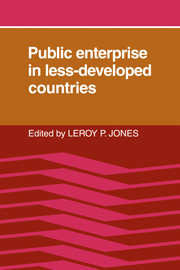Book contents
- Frontmatter
- Contents
- List of contributors
- List of figures and tables
- Preface
- 1 Introduction
- Part I Why public enterprise?
- Part II Principal-agent relationships: Who should control public enterprises?
- Part III How are decisions made in practice?
- 6 Comparing state enterprises across international boundaries: the Corporación Venezolana de Guayana and the Companhía Vale do Rio Doce
- 7 Decision structure, technological self-reliance, and public-enterprise performance
- 8 Labor–management conflict resolution in state-owned enterprises: a comparison of public- and private-sector practices in India
- Part IV How do public enterprises behave in international markets?
- Part V How does risk alter public-enterprise decisions?
- Part VI How are incentive structures to be designed?
- Part VII How does public enterprise compare with other intervention mechanisms in overcoming particular problems?
7 - Decision structure, technological self-reliance, and public-enterprise performance
Published online by Cambridge University Press: 04 August 2010
- Frontmatter
- Contents
- List of contributors
- List of figures and tables
- Preface
- 1 Introduction
- Part I Why public enterprise?
- Part II Principal-agent relationships: Who should control public enterprises?
- Part III How are decisions made in practice?
- 6 Comparing state enterprises across international boundaries: the Corporación Venezolana de Guayana and the Companhía Vale do Rio Doce
- 7 Decision structure, technological self-reliance, and public-enterprise performance
- 8 Labor–management conflict resolution in state-owned enterprises: a comparison of public- and private-sector practices in India
- Part IV How do public enterprises behave in international markets?
- Part V How does risk alter public-enterprise decisions?
- Part VI How are incentive structures to be designed?
- Part VII How does public enterprise compare with other intervention mechanisms in overcoming particular problems?
Summary
The characteristic feature of the development process – since World War II in both the developed and the developing countries – is the deliberate assumption by the state of the function of regulating the pace and pattern of socioecpnomic development. The major declared objectives of state policies in less-developed countries (LDCs) include sustained progressive improvement in the levels of living, reduction of inequality in the distribution of income, wealth, and economic power, and technological self-reliance (which constitutes both an instrument as well as an objective). It has been difficult, however, in a large number of LDCs to translate these multiple and often conflicting objectives into operative goals of the various holons subsystems of the government organizational system – with the result that these objectives, in actual fact, have remained largely of ceremonial significance.
The economist's solution to this problem is quite simple. When the multiple objectives are appropriately weighted, there is a consistent preference or objective function. Given “right” prices – decision signals – it would not be difficult to choose the best course from all the possible alternative courses of action. However, this is not how organizations function in the real world of considerable complexity and uncertainty. The operative goals and the information structure – or to use Arrow's expressive phrase, the agenda – of each subsystem is a function of its location in the multileveled hierarchy of the government system, its past history, the quality of its top management, and the complexity of its task and social environment. It is thus essential to study the decision structure and processes of the organizational system and how they change.
- Type
- Chapter
- Information
- Public Enterprise in Less Developed Countries , pp. 129 - 140Publisher: Cambridge University PressPrint publication year: 1982
- 1
- Cited by

